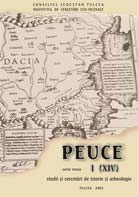Studiu antropologic al osemintelor descoperite în cripta basilicii de la Murighiol (anticul Halmyris)
Anthropological study of human bones discovered in the crypt of Halmyris basilica (Murighiol of nowadays, Tulcea County)
Author(s): Andrei Dorian Soficaru, Nicolae MiriţoiuSubject(s): Archaeology
Published by: Institutul de Cercetari Eco-Muzeale Tulcea - Institutul de Istorie si Arheologie
Keywords: Dobrogea; Halmyris; Murighiol; epocă romană; basilica; criptă martirică; studiu antropologic; Dobrogea; Halmyris; Murighiol; Roman epoch; basilica; crypt of martyrs (martyrs crypt); anthropological study
Summary/Abstract: This study concerns the anthropological analysis of human bones discovered in the crypt of Halmyris basilica (Murighiol of nowadays, Tulcea County) in the summer of 2001. This discovery belongs to archaeologists M. Zahariade and O. Bounegru. Discoverers assigned the bones in the first room of crypt to Epictet and Astion, two Christian martyrs killed in Halmyris on July 8, 290. These remnants were not placed in anatomical connection but anthropological analyses have confirmed that they belonged to two men, the first being 64 – 67 years old and the second 30 – 40 years old. According to the anthropological study, during their lives both persons suffered for affections of their spines. The first proved signs of a chronic arthropathy and the second a fracture of L 1 lumber vertebra. Some traces of perimortem violence were also to be shown, as skeleton 1 had fractures of scapulas and destructions of its mandible, while skeleton 2 had been inflicted by a sharp object an its right humerus and also shown a fracture of left fibula and destructions of mandible. The most likely cause of death could by tracked on skeleton 2, which wears some scars from sword blow on inferior articular facets of its atlas. Room 2 contained both human and animal bones; the human bones belonging 48 – years – old woman (tomb 2) but their could be also identified some other human remains of 3 children and 9 adults. Animal belonged to bovines, gouts, sheep, pigs and birds. Conclusions refer to identifications of skeletons 1 and 2 with martyrs Epictet and Astion, as a result of “written source” (Acta Sanctorum) confrontation with anthropological analyses undertaken.
Journal: Peuce (Serie Nouă) - Studii şi cercetari de istorie şi arheologie
- Issue Year: I/2003
- Issue No: 1
- Page Range: 531-580
- Page Count: 50
- Language: Romanian

